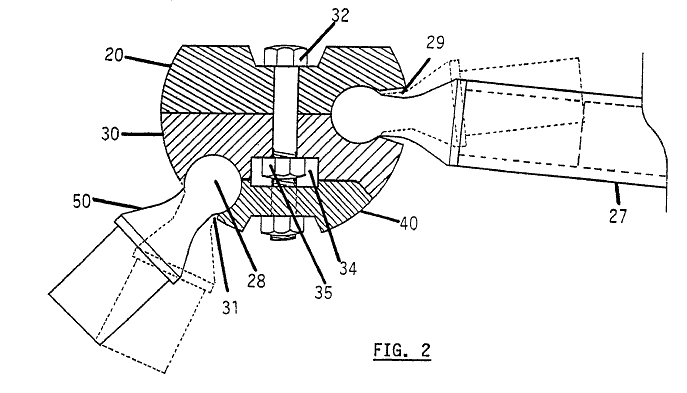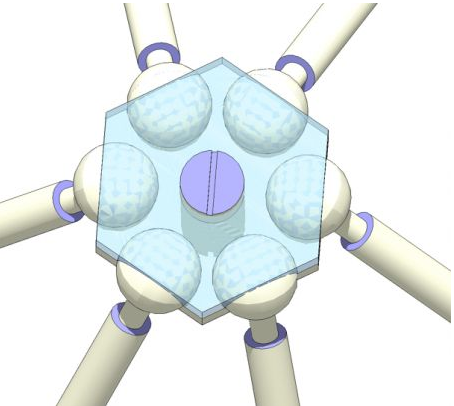ATTN: TaffGoch >> Bucky on stage!!
-
TaffGoch, your work with SU truly inspires me, and I thought you'd appreciate this...
I have just seen Joe Spano's astonishing one-man performance as Bucky
Fuller at the Rubicon Theatre in Ventura, CA.Rubicon Theatre Company: R. Buckminster Fuller: THE HISTORY (and
Mystery) OF THE UNIVERSE
http://www.rubicontheatre.org/season/0708/02_mystery/index.phpPerhaps my saddest regret in life was that I never got to see Bucky
speak in person (I've only seen video... which is better than nothing, I guess!).
Now I feel like I have!Google Video - Everything I Know - R. Buckminster Fuller
http://video.google.com/videoplay?docid=-938394498520786588Spano was magical, capturing Bucky's accent & slight stammer and
mannerisms, and the script hit all the key concepts & terminology... I don't want to
get started on all the neat little details.Suffice it to say that anybody living within driving distance who's impressed by your virtual Dymaxion Artifacts, but not too familiar with Bucky Fuller, needs to see this!
-
CLJ,
I've read books, both by and about, Bucky, and have many in my personal library. Going on 30 years, I've been fascinated by his inventive creativity and engineering contributions (his geodesic and Dymaxion stuff.)
Once he gained some fame, he became more outspoken about philosophies, rather than practicalities. While I appreciate his contributions to architecture and engineering, I simply can't stomach his philosophical ramblings (and he did ramble-on in both his speeches and writings.)
So, I generally accept Bucky-the-engineer, and disregard Bucky-the-crank. (But I'm a "left-brained" scientist/mathematician. It appears that Fuller used both sides of his brain.)
I would think that the stage presentation was primarily philosophical (I mean, really, how much engineering can you put on stage?)
So, I'm curious, how "balanced" was the Rubicon performance?
Regards,
Taff -
Interesting discussion guys. I discovered Fuller as a young teen. Might have been in a Whole Earth Catalog. It turned out my dad was a bit of a Fuller fan and had some of his books. I read/skimmed through those and found some of his work interesting but a lot either too technical or too philosophical. I tried a couple of other times in high-school and college to read more of his work but none of it really clicked with me.
I think Fuller's impact on the culture reached a high point with the building of the US pavilion geodesic dome at the Montreal Expo in 1967 and has never really recovered from the fire that burned the outer shell of that dome in 1976. I remember watching some PBS show on the history of architecture in which the host (perhaps Brendan Gill) explicitly used the fire to dismiss geodesic structures as anything more than radar domes or architectural curiosities.
As I started playing with TINs (triangular irregular networks) in SketchUp they reminded me of Fuller's work. However, I found them more compelling than the geodesic stuff because they support much more fluid, flexible and organic shapes. They are not constrained by Platonic ideals.
The more I played with TINs the more I wanted to build analog physical models out of TIN lattices. I searched for toys or building modeling kits that would support the building of TINs and found nothing of any real use. I settled on using straws and pipe cleaners and produced a number of works which confirmed my belief that a TIN building toy has a lot of potential.
When I heard about the Buckminster Fuller Challenge I decided to blow $50 and submit an entry proposal centered around developing a TIN building toy.
Some models related to this toy idea are on the warehouse here.
I also have some information on the Open Architectural Network here.
I'm also developing ideas for using a TIN roof structure which allows for non-rectilinear house shapes. Some models related to that are on the warehouse here.
So I feel that I'm working in the vein that Fuller developed but perhaps freed -thanks to computer technology and SketchUp- from some of the constraints that limited him.
TaffGoch, I've always admired the work you've share on the 3d-warehouse! It's great to have those models available to use and learn from.
Fred
-
Yeah, I've never been able to make it through an entire book by Bucky (well, except for Operating Manual for Spaceship Earth). His penchant for inventing words and unconventional sentence structure gave me a headache.
I became a fan of his by reading Buckminster Fuller's Universe: An Appreciation by Lloyd Steven Sieden in '91.
Funny thing, I'd been exposed to his works all my life (my 3rd grade class built a cardboard geodesic dome, and there was a dome home directly in line-of-sight from my bedroom window), but it wasn't until after reading the Sieden book at age 28 that something clicked.
One rainy day, I sat down with a box of toothpicks and some Elmer's glue, and made a triangle, and the light went on: "Hey, y'know, you can't make a crooked triangle!"
Then I made a tetrahedron... then an octet truss...
Later, after scouring the used bookstores and snatching up every Bucky book I could find (mostly for the pictures & diagrams), I moved up to tetrahelixes, domes & tensegrity models.
I hung out at the Buckminster Fuller Institute a lot when it was based here in L.A.
They liked my models.
But I was never able to read more than a few pages of Synergetics, Critical Path, etc., or watch more than a few minutes of video of him.This play managed to hold my attention, since it was largely biographical. The philosophy was boiled down to where it was digestable.
There was an earlier stage production (written/directed by Alice Wilson) with Brad Armstrong as Bucky, that was almost identical in format...
YouTube - Bucky
http://www.youtube.com/watch?v=CLWEDfSjD5w...but the Rubicon production (written/directed by D.W. Jacobs) seemed more authentic:
Joe Spano's performance was far closer to the video clips I've seen of Bucky (but in a good way!) than Brad Armstrong's was.
Spano did a great job with the hands-on stuff, too!
Made good use of the dowel & surgical tubing Isotropic Vector Matrix ("Jitterbug"), and also had a jumbo version that he could stand inside of!Funny story: There was an elderly couple sitting next to me that I had "briefed" about Bucky before the show, with the woman sitting closest. She'd known nothing of Bucky, while her husband had attended Bucky lectures.
When Spano started demonstrating the IVM by contracting & expanding it rhythmically, I whispered "Jitterbug" ever so softly, hoping that the woman heard me.
About 3 seconds later, Spano said, "It's like a jitterbug, isn't it?"
The woman and I turned to each other with huge smiles. Guess she heard me. -
Fred,
How about that - I've valued your models, too (one of my few 'bookmarks' to the 3DWarehouse.)
Funny, you mention the 'Whole Earth Catalog.' I, too, cut my teeth on a lot of the information from that first book. (I look at it as a precursor to the internet.) From there, I learned about 'DomeBook II' and obtained a copy. That book is still in my library, and still fascinates my students, even today.
For years, I've collected information regarding the construction of geodesic structures (thank God for the internet!) Your hub design reminded me of a patent I had downloaded a couple of years ago.
If you use Google's Patent search you can find a lot of 'prior art' on inventions related to 'space frame' construction (what you call TIN structures.) If you search on terms 'space frame,' 'structure,' 'connector' and similar, you get hundreds of hits.
The specific patent I recalled is number 4974986:
http://www.google.com/patents?id=MYcnAAAAEBAJ&dq=patent;4974986
This is only one example of many similar designs. I don't want to 'burst any bubbles' here, but advise that you be careful. If you make any money on this venture, you can be sure that the lawyers will start 'crawling out of the woodwork' to claim patent infringement. You'd best have your own patent attorney beforehand.
Maybe they won't care if it's a toy, and doesn't threaten anyone else's profits (but you can never tell with lawsuits nowadays.)
Don't let legal issues stop you - just be prepared.
Regards,
Taff

-
Chris,
I have copies of the Synergetics books. You're right, they're not much for reading. I use them as reference sources, and even then, only a few sections of the material have practical application (to me, anyway.)
Man! - I never even considered actually sitting down and READING Synergetics. Maybe the next time I'm having trouble getting to sleep....
Regards,
Taff -
Taff,
Thanks for the patent/lawsuit information and heads up. I considered the possibility of doing something entrepreneurial with the TIN toy idea but backed away after talking with a few people. In particular, the CEO of Zome, who I unsuccessfully tried to interest in the idea, was quite enlightening about the difficult process of getting a new building toy into the market. I then decided to put the idea out there as an open source project. The basic pieces of the "system" are so simple and so few that this didn't seem overly presumptuous to me. Only four different pieces are necessary: 1-the hexagonal hub halves; 2-the bolt to tighten these together; 3-the spherical joints that rest in the hubs; and 4-the hollow threaded rods connecting the spherical joints. These can be seen in the image below.

While the Zome toy referenced above is well designed for building space frames it does not support building irregular TINs.
Fred
-
A week or two ago the New Yorker had an article about Bucky Fuller. It discussed his personality and how it influenced his influence, as well as some of the doors he opened.
I also was turned on to him (and other interests) by the Whole Earth Catalog and CoEvolution Quarterly.
I agree that geodesic domes opened a big door, but they have the inherent limits of strongly engineered mathematical shapes. That is, they don't have a lot of heart to them. There is very little you can do aesthetically with a perfect geometry such as a sphere. Living here on earth, we need to respect our physical needs as well as gravity, and a 3D radially symmetric geometry doesn't do that.
Your TIN toy shows how to start building alternate, more flexible geometries. A lot depends on the friction of the joints, as you are really making hexagons, not triangles because of the small distance between the spherical connectors. The hubs can twist under assymetric load.
I was fascinated to hear a lecture by one of the architects finishing Antonio Gaudi's Sagrada Familia cathedral. Apparently, Gaudi also worked from a mathematical base, especially catenaries, parabolas, ellipses, and surfaces of revolution. He then textured the surfaces by constructing them from rough masonry. He took the additional step of refining and re-refining the mathematics until a strong aesthetic emerged. While overly expressive to many (hence the term gaudy) his work shows as strongly physical rather than intellectual like Bucky's.
-
i agree,

this is from Manuel Hidalgo Herrera investigating the Gaudi ways of reaching Geometry.
I´ve tried to upload the book, but its too heavy.
I´ll see if i can get a link.
-
got it
here you have the link to the Marvels ))))
))))http://en.wiki.mcneel.com/default.aspx/McNeel/GeometriaInformaticaArquitectonica.html
spanish yet
you will like it fbartels
if you have not seen it yet
Advertisement







